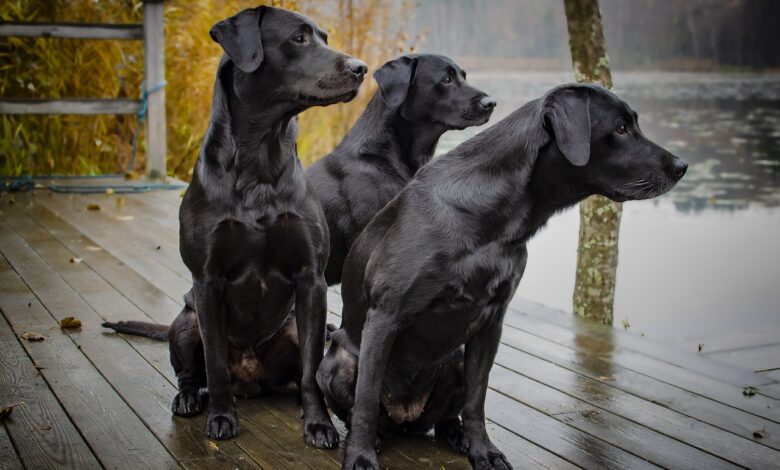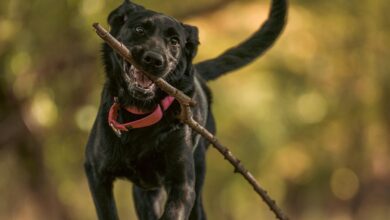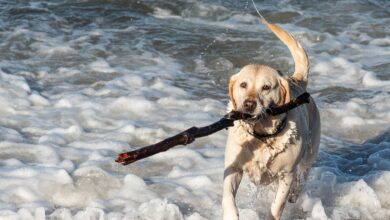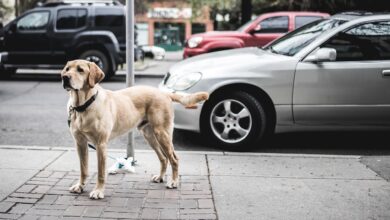
BY BERNADETTE ROBERTS
There are important considerations and potential differences when travelling with a Labrador that is trained as a gun dog or working dog. Gun dogs, like other working dogs, often have specific training, routines, and physical requirements that may influence how you approach travel. Here’s how travelling with a gun dog differs and what additional factors you should consider:
Routine and Training Needs
Gun dogs are typically highly trained and accustomed to specific routines. This means that disrupting their schedule can cause stress or confusion. When travelling, try to maintain their training regimen as much as possible. If your gun dog is used to daily training or retrieving exercises, plan stops during the journey where you can allow them to stretch and engage in some light practice, such as retrieving a dummy or basic obedience drills.
It’s also essential to reinforce commands during travel to maintain their focus and discipline. Familiar commands like “sit,” “stay,” “heel,” and “retrieve” may need extra reinforcement in unfamiliar environments, such as train stations, airports, or new destinations.
Energy Management
Gun dogs, particularly Labradors, are high-energy animals bred for endurance and activity. Long journeys can be frustrating for them if they don’t get opportunities to release that energy. While a regular Labrador might be satisfied with a few bathroom breaks and a short walk, a gun dog may need longer breaks that include physical activity, such as running or retrieving games, to keep them calm and focused.
For car travel, ensure you plan your route with frequent stops where your dog can safely exercise. For train travel, research whether the stations on your route have grassy areas or nearby parks. If you’re flying, look for airports with pet relief areas and allow extra time for a long walk before the flight.
Crate and Transportation Considerations
Gun dogs are often accustomed to crates or kennels, as they’re frequently used for transportation for hunting or training sites. However, a gun dog’s crate may need to be different from a regular travel crate. For example:
Carriers or Crates for Travel: Gun dog crates are often made of more durable materials to withstand frequent use. Ensure the crate is large enough for your dog to lie down comfortably but secure enough for safe transport.
Ventilation: If you’re transporting your gun dog in a specialized kennel in the back of a truck or SUV, ensure the crate has proper ventilation and is insulated if you’re travelling in extreme weather conditions.
Equipment and Accessories
Travelling with a gun dog often requires bringing additional equipment. In addition to standard accessories like a leash, harness, and water bowl, you might need to pack specific tools and gear, such as:
Dummy Training Equipment: If your gun dog practices retrieving with dummies, bring a few for training during breaks.
Whistle or Clicker: Many gun dogs are trained to respond to whistle or clicker cues, so don’t forget these important tools.
Protective Gear: If you’re travelling to hunting grounds, protective gear such as a blaze orange vest or paw protection may be necessary.
Cleaning Supplies: Gun dogs often encounter mud, water, or debris during hunting trips. Bring grooming wipes or towels to keep them clean during the journey.
Special Food Requirements: If your gun dog is actively working or training during travel, they may require higher-calorie food to maintain their energy levels. Pack enough food for the journey and their work.
Behavioural Traits
Gun dogs are bred for focus, drive, and work ethic, but these traits can sometimes lead to overexcitement or restlessness when they’re out of their usual environment. If your gun dog associates travel with hunting or training, they may become overly eager during the journey. To manage this:
- Ensure your dog is calm before entering the vehicle or crate. Exercise them thoroughly beforehand to reduce pent-up energy.
- Bring familiar items like a favourite blanket or toy to help them relax during travel.
- Use calming techniques if necessary, such as playing soothing music or using a calming spray designed for dogs.
Destination-Specific Considerations
If you’re travelling with a gun dog for a hunting trip or field trial, your destination may influence your preparations. For instance, if you’re travelling to a hunting site, ensure your dog is acclimated to the terrain and climate. If you’re attending a competition, keep your dog well-rested and hydrated to ensure they perform at their best.
Additionally, be mindful of local laws and regulations regarding hunting dogs, leashes, or permits. Some areas may require specific paperwork, especially if you’re travelling across borders. For instance, if your gun dog is being transported internationally, you’ll need to ensure you meet all health and vaccination requirements, and you may also need a permit for the hunting activity.
Travelling with Firearms and Equipment
If you’re travelling with your gun dog for hunting purposes, you’ll likely have additional gear, such as firearms or hunting equipment. When travelling by car, firearms should be securely stored and locked separately from your dog’s crate. For train or air travel, check the specific regulations regarding transporting firearms, as these may affect your dog’s journey.
Some airlines or trains may have restrictions on transporting hunting equipment and animals together, so confirm these details well in advance.
Journey Length
Journey length considerations are similar for a gun dog and a family Labrador, but their heightened energy and work drive make frequent breaks even more essential. A car journey of six to eight hours is manageable as long as you incorporate stops for exercise. Train journeys can be similarly managed, with regular opportunities for your gun dog to stretch and relieve themselves. For flights, the same rules about crate training, hydration, and pre-flight exercise apply, but remember that a gun dog may be more restless or anxious during long flights due to their active nature.
After the Journey
Once you’ve reached your destination, it’s important to give your gun dog plenty of time to adjust and decompress. Allow them to stretch, drink, and eat, and if they’ve been confined for a long time, provide them with a short training session or retrieving game to refocus their energy. This will help them settle into their new environment and prepare for the work ahead, whether it’s hunting, competing, or simply enjoying time outdoors.
Travelling with a Labrador gun dog requires extra preparation and attention to their working instincts and high energy levels. By maintaining their training routines, managing their energy, and bringing the right equipment, you can ensure that your gun dog stays happy, healthy, and ready for any adventure. Whether your trip involves hunting grounds, field trials, or simply exploring new places, a well-prepared journey will strengthen the bond between you and your hardworking companion.





